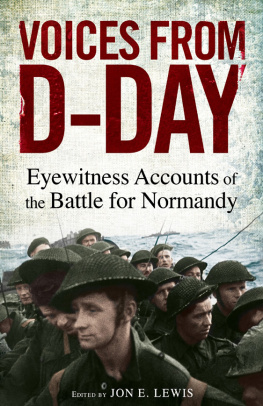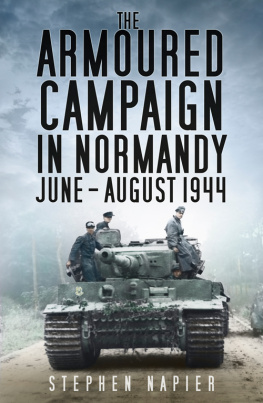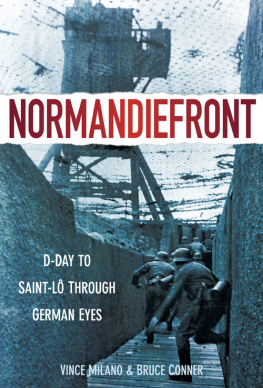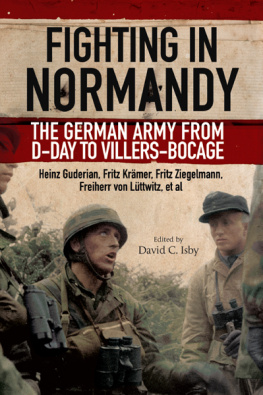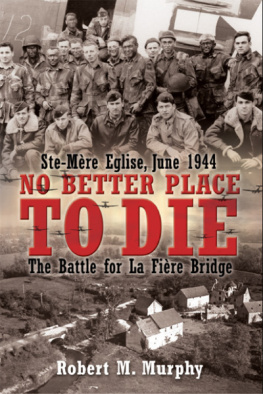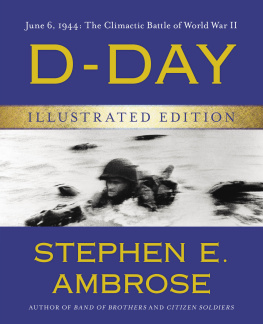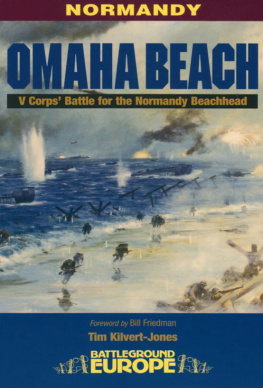JON E. LEWIS is a writer and historian. His many previous books include the bestselling The Mammoth Book of True War Stories, Spitfire: The Autobiography and The Mammoth Book of Cover-ups.
Constable & Robinson Ltd
55-56 Russell Square
London WC1B 4HP
www.constablerobinson.com
First published in the UK as Eyewitness D-Day
by Robinson Publishing Ltd., 1994
This revised paperback edition published by Robinson,
an imprint of Constable & Robinson Ltd., 2014
Copyright J. Lewis-Stempel 1994, 2004, 2014
The right of J. Lewis-Stempel to be identified as the author of this work has been asserted by him in accordance with the Copyright, Designs & Patents Act 1988
All rights reserved. This book is sold subject to the condition that it shall not, by way of trade or otherwise, be lent, re-sold, hired out or otherwise circulated in any form of binding or cover other than that in which it is published and without a similar condition including this condition being imposed on the subsequent purchaser.
A copy of the British Library Cataloguing in Publication
Data is available from the British Library
ISBN 978-1-47210-398-7 (paperback)
ISBN 978-1-47210-399-4 (ebook)
Printed and bound in the UK
3 5 7 9 10 8 6 4 2
Cover by Stuart Polson
CONTENTS

INTRODUCTION
It was going to be, said Admiral Sir Bertram Ramsay to a group of his captains gathered before him, the greatest amphibious operation of all time. He apologized for the superlatives, but believed that this time they were necessary. Three days later, on 6 June 1944, the Allied invasion of Normandy of which Ramsay was naval commander took place. The Allied armada involved over 5,000 craft, and had by the end of the longest day landed 156,000 men, and breached Hitlers much vaunted defensive wall. Ramsay had not exaggerated.
Yet, dramatic and historic though the events of D-Day were, they were but the opening shots of a much larger and equally remarkable battle, the battle for Normandy. A legend has grown up in the years since the war to the effect that the invasion was a matter of one glorious day in June, followed by a triumphal march on Paris. The reality was conspicuously different. It took the Allies ten weeks of bloody, painful fighting to get out of Normandy. At times the infantry casualty rate rivalled that of the Western Front in World War I. Only the lucky got out of Normandy alive.
The reason for the peculiar bloodiness of Normandy was simple; in the words of one British soldier, the Germans were bastard hard to beat. The Germans had fifty-nine divisions in France, many of them of second-rate quality and composed of volunteer foreign (Russian, Polish, Mongolian and so forth) troops. However, even these divisions proved stubborn denying the Allies most of their inland objectives on 6 June itself and there were enough crack divisions like 352 Infantry, Panzer Lehr and, especially, the 12 SS Panzer to make things very difficult indeed. The Allied chiefs were all too aware of the formidability of the German Army, and that it was likely only to be beaten in the most propitious circumstances. That is, when the Germans were outnumbered, out-gunned, out-planed, out-guessed and out of luck. These circumstances were some considerable time in the making.
The Allied invasion, later to be codenamed Overlord, first stirred into life in late 1941 with the entry of the United States into the war, and was followed by a huge build-up of American forces in Britain from 1942 onwards. The original plan, as conceived by General Sir Frederick Morgan, Chief of Staff to the Supreme Allied Commander (COSSAC), foresaw a first-day landing by three divisions. Eventually, this was revised by the Supreme Commander, Eisenhower, and the Field Commander, Montgomery, to five divisions on a broader front. To ensure that adequate supplies reached the Allied divisions after they landed, two prefabricated artificial harbours, or Mulberries, were built to be towed to Normandy on the big day. An underwater pipeline, PLUTO, was devised to hasten the supply of fuel to the invasion army. To overcome the German beach obstacles a strange population of tanks, nicknamed funnies, was created by Major-General Percy Hobart, among them an amphibious tank, the DD, and the mine-clearing flail tank. The men who would fight the invasion were trained for months. Even years. The preparations were meticulous.
It was, of course, impossible to conceal from the Germans that an invasion would happen, as the Germans knew it must. The trick was to keep the Germans guessing as to when and exactly where in France it would happen.
In spring 1944 the Allies began a brilliantly successful subterfuge, Operation Fortitude, which festooned the ports and aerodromes of south-east England with dummy landing craft and gliders. Heavy hints were dropped before German ears about Pattons First US Army Group and its readiness to cross the Straits of Dover. More and more the Germans, especially the Wehrmachts Commander-in-Chief in the West, Von Rundstedt, began to believe that the Pas de Calais would be the invasion site. In fact the Allies chosen landing place was the bay of the Seine, the fifty-mile sweep of Normandy coast from Cape dAntifer to the Point of Barfleur. If the German High Command had settled its internal bickering and its prejudices it would have realized that this was the only possible place for a mass landing. Most of the land behind the beaches in Seine bay is flat, the tides are mild and the approaches free of natural obstacles.
The Allies selected five main assault beaches. The Americans had the two most westerly, Utah and Omaha, the British Sword, Juno and Gold. The initial assault would be carried out by the British 3rd Division on Sword, the Canadian 3rd Division on Juno, the British 50th Division on Gold, the 4th US Division on Utah and the lst US Division on Omaha. The left flank of the British assault was to be protected by the British 6th Airborne Division; the right flank of the American assault by its 82nd and 101st Airborne Divisions. The invasion would be prefaced by extensive bombing of roads, railways and German positions, the chaos added to by the attentions of the Resistance and a small group of SAS. Minesweepers would clear gaps in the German minefields which ran up the middle of the English Channel. The date for the invasion, the day when all the cards would come together in the right combination, was set by Eisenhower for 5 June 1944.
There was, though, a joker in the pack: the weather. The invasion required a calm sea. The weather stood fair for France until just three days before the off, when a high-pressure area above the Azores began to disintegrate. Eisenhowers meteorologist, Group-Captain Stagg, advised a postponement. But when could they go? The outcome of the Allies mightiest operation came to rest on Staggs judgement. He forecast a window in the bad weather for Tuesday, 6 June. This left Eisenhower the choice to go on the 6th or wait three weeks until the tidal requirements were again favourable but by which time the morale of keyed-up troops would have likely sunk. Ike went for the 6th. Luck was with him. The German weather experts divined 6 June as far too bad a day to launch an invasion. Consequently, the Germans dropped their guard. Some senior officers, like Rommel, even took leave. By coincidence, the 6th was the start date for a Wehrmacht war game, attended by senior German officers from Normandy. When the Allies came ashore on the morning of 6 June much of the head of the German army was missing. Eisenhower, had he known it, could probably not have picked a better day.
Next page
